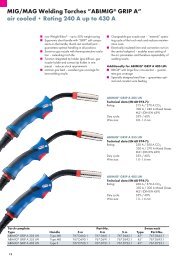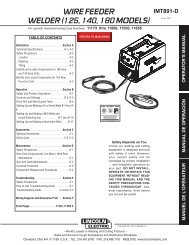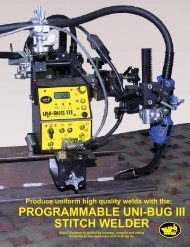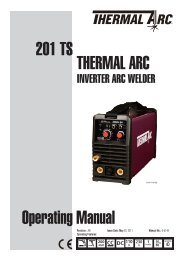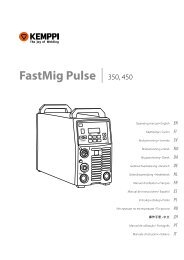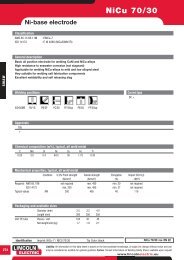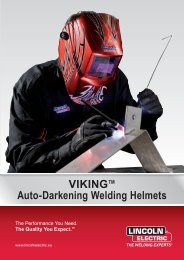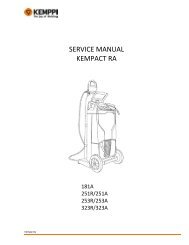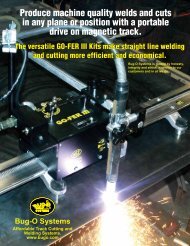invertec 135s, 150s & 170s - Rapid Welding and Industrial Supplies ...
invertec 135s, 150s & 170s - Rapid Welding and Industrial Supplies ...
invertec 135s, 150s & 170s - Rapid Welding and Industrial Supplies ...
Create successful ePaper yourself
Turn your PDF publications into a flip-book with our unique Google optimized e-Paper software.
IM201301/2011Rev. 3INVERTEC 135S, 150S & 170SOPERATOR’S MANUALENGLISHLINCOLN ELECTRIC ITALIA S.r.lVia Fratelli Canepa 8, 16010 Serrà Riccò (GE), Italiawww.lincolnelectric.eu
Declaration of conformityLINCOLN ELECTRIC ITALIA S.r.l.Declares that the welding machine:INVERTEC 135SINVERTEC 150SINVERTEC 170Sconforms to the following directives:2006/95/CEE, 2004/108/CEE<strong>and</strong> has been designed in compliance with thefollowing st<strong>and</strong>ards:EN 60974-1, EN 60974-10(2009)Dario GattiEuropean Engineering Director MachinesLINCOLN ELECTRIC ITALIA S.r.l., Via Fratelli Canepa 8, 16010 Serra Riccò (GE), Italia12/05EnglishIEnglish
THANKS! For having choosen the QUALITY of the Lincoln Electric products. Please Examine Package <strong>and</strong> Equipment for Damage. Claims for material damaged in shipment must be notifiedimmediately to the dealer. For future reference record in the table below your equipment identification information. Model Name, Code &Serial Number can be found on the machine rating plate.Model Name:………………...…………………………….…………………………………………………………………………………………..Code & Serial number:………………….……………………………………………….. …………………………………………………….……………..Date & Where Purchased:12/05…………………………………………………………………...……………………….…………………………………………..ENGLISH INDEXSafety .............................................................................................................................................................................. 1Installation <strong>and</strong> Operator Instructions .............................................................................................................................. 2Electromagnetic Compatibility (EMC) .............................................................................................................................. 4Technical Specifications .................................................................................................................................................. 5WEEE.............................................................................................................................................................................. 6Spare Parts...................................................................................................................................................................... 6Electrical Schematic ........................................................................................................................................................ 6Accessories ..................................................................................................................................................................... 6EnglishIIEnglish
Safety01/11WARNINGThis equipment must be used by qualified personnel. Be sure that all installation, operation, maintenance <strong>and</strong> repairprocedures are performed only by qualified person. Read <strong>and</strong> underst<strong>and</strong> this manual before operating this equipment.Failure to follow the instructions in this manual could cause serious personal injury, loss of life, or damage to thisequipment. Read <strong>and</strong> underst<strong>and</strong> the following explanations of the warning symbols. Lincoln Electric is not responsiblefor damages caused by improper installation, improper care or abnormal operation.WARNING: This symbol indicates that instructions must be followed to avoid serious personal injury,loss of life, or damage to this equipment. Protect yourself <strong>and</strong> others from possible serious injury ordeath.READ AND UNDERSTAND INSTRUCTIONS: Read <strong>and</strong> underst<strong>and</strong> this manual before operatingthis equipment. Arc welding can be hazardous. Failure to follow the instructions in this manual couldcause serious personal injury, loss of life, or damage to this equipment.ELECTRIC SHOCK CAN KILL: <strong>Welding</strong> equipment generates high voltages. Do not touch theelectrode, work clamp, or connected work pieces when this equipment is on. Insulate yourself fromthe electrode, work clamp, <strong>and</strong> connected work pieces.ELECTRICALLY POWERED EQUIPMENT: Turn off input power using the disconnect switch at thefuse box before working on this equipment. Ground this equipment in accordance with local electricalregulations.ELECTRICALLY POWERED EQUIPMENT: Regularly inspect the input, electrode, <strong>and</strong> work clampcables. If any insulation damage exists replace the cable immediately. Do not place the electrodeholder directly on the welding table or any other surface in contact with the work clamp to avoid therisk of accidental arc ignition.ELECTRIC AND MAGNETIC FIELDS MAY BE DANGEROUS: Electric current flowing through anyconductor creates electric <strong>and</strong> magnetic fields (EMF). EMF fields may interfere with somepacemakers, <strong>and</strong> welders having a pacemaker shall consult their physician before operating thisequipment.CE COMPLIANCE: This equipment complies with the European Community Directives.ARTIFICIAL OPTICAL RADIATION: According with the requirements in 2006/25/EC Directive <strong>and</strong>EN 12198 St<strong>and</strong>ard, the equipment is a category 2. It makes m<strong>and</strong>atory the adoption of PersonalProtective Equipments (PPE) having filter with a protection degree up to a maximum of 15, asrequired by EN169 St<strong>and</strong>ard.FUMES AND GASES CAN BE DANGEROUS: <strong>Welding</strong> may produce fumes <strong>and</strong> gases hazardous tohealth. Avoid breathing these fumes <strong>and</strong> gases. To avoid these dangers the operator must useenough ventilation or exhaust to keep fumes <strong>and</strong> gases away from the breathing zone.ARC RAYS CAN BURN: Use a shield with the proper filter <strong>and</strong> cover plates to protect your eyes fromsparks <strong>and</strong> the rays of the arc when welding or observing. Use suitable clothing made from durableflame-resistant material to protect you skin <strong>and</strong> that of your helpers. Protect other nearby personnelwith suitable, non-flammable screening <strong>and</strong> warn them not to watch the arc nor expose themselves tothe arc.WELDING SPARKS CAN CAUSE FIRE OR EXPLOSION: Remove fire hazards from the weldingarea <strong>and</strong> have a fire extinguisher readily available. <strong>Welding</strong> sparks <strong>and</strong> hot materials from the weldingprocess can easily go through small cracks <strong>and</strong> openings to adjacent areas. Do not weld on anytanks, drums, containers, or material until the proper steps have been taken to insure that noflammable or toxic vapors will be present. Never operate this equipment when flammable gases,vapors or liquid combustibles are present.WELDED MATERIALS CAN BURN: <strong>Welding</strong> generates a large amount of heat. Hot surfaces <strong>and</strong>materials in work area can cause serious burns. Use gloves <strong>and</strong> pliers when touching or movingmaterials in the work area.English1English
SAFETY MARK: This equipment is suitable for supplying power for welding operations carried out inan environment with increased hazard of electric shock.CYLINDER MAY EXPLODE IF DAMAGED: Use only compressed gas cylinders containing thecorrect shielding gas for the process used <strong>and</strong> properly operating regulators designed for the gas <strong>and</strong>pressure used. Always keep cylinders in an upright position securely chained to a fixed support. Donot move or transport gas cylinders with the protection cap removed. Do not allow the electrode,electrode holder, work clamp or any other electrically live part to touch a gas cylinder. Gas cylindersmust be located away from areas where they may be subjected to physical damage or the weldingprocess including sparks <strong>and</strong> heat sources.Installation <strong>and</strong> Operator InstructionsRead this entire section before installation or operationof the machine.Location <strong>and</strong> EnvironmentThis machine can operate in harsh environments.However, it is important that simple preventativemeasures are followed to assure long life <strong>and</strong> reliableoperation:Do not place or operate this machine on a surfacewith an incline greater than 15° from horizontal.Do not use this machine for pipe thawing.This machine must be located where there is freecirculation of clean air without restrictions for airmovement to <strong>and</strong> from the air vents. Do not coverthe machine with paper, cloth or rags whenswitched on.Dirt <strong>and</strong> dust that can be drawn into the machineshould be kept to a minimum.This machine has a protection rating of: 135S: IP21 150S: IP23 170S: IP23Keep it dry when possible <strong>and</strong> do not place it on wetground or in puddles.Locate the machine away from radio controlledmachinery. Normal operation may adversely affectthe operation of nearby radio controlled machinery,which may result in injury or equipment damage.Read the section on electromagnetic compatibility inthis manual.Do not operate in areas with an ambienttemperature greater than 40°C.Input Supply ConnectionCheck the input voltage, phase, <strong>and</strong> frequency suppliedto this machine before turning it on. The allowable inputvoltage is indicated in the technical specification sectionof this manual <strong>and</strong> on the rating plate of the machine.Be sure that the machine is grounded. 150S / 170S:The machines are designed to operate on enginedriven generators as long as the auxiliary cansupply adequate voltage, frequency <strong>and</strong> power asindicated in the "Technical Specification" section ofthis manual. The auxiliary supply of the generatormust also meet the following conditions: Vac peak voltage: below 410V. Vac frequency: in the range of 50 <strong>and</strong> 60Hz. RMS voltage of the AC waveform: 230Vac ±15%.It is important to check these conditions becausemany engine driven generators produce highvoltage spikes. Operation of this machine withengine driven generators not conforming to theseconditions is not recommended <strong>and</strong> may damagethe machine.Output ConnectionsA quick disconnect system using Twist-Mate TM cableplugs is used for the welding cable connections. Referto the following sections for more information onconnecting the machine for operation of stick welding(MMA) or TIG welding. (+) Positive Quick Disconnect: Positive outputconnector for the welding circuit. (-) Negative Quick Disconnect: Negative outputconnector for the welding circuit.Stick <strong>Welding</strong> (MMA)First determine the proper electrode polarity for theelectrode to be used. Consult the electrode data for thisinformation. Then connect the output cables to theoutput terminals of the machine for the selected polarity.Shown here is the connection method for DC(+) welding.Make sure the power available at the input connection isadequate for normal operation of the machine. The fuserating <strong>and</strong> cable sizes are both indicated in the technicalspecification section of this manual.Input Supply From Engine Driven Generators 135S:EnglishWARNINGThis machine is not designed to operate on enginedriven generators. Operation of this machine withengine driven generators may damage the machine.2Connect the electrode cable to the (+) terminal <strong>and</strong> thework clamp to the (-) terminal. Insert the connector withthe key lining up with the keyway <strong>and</strong> rotateapproximately ¼ turn clockwise. Do not over tighten.For DC(-) welding, switch the cable connections at themachine so that the electrode cable is connected to (-)English
<strong>and</strong> the work clamp is connected to (+).TIG <strong>Welding</strong>This machine does not include a TIG torch necessary forTIG welding, but one may be purchased separately.Refer to the accessories section for more information.Most TIG welding is done with DC(-) polarity shownhere. If DC(+) polarity is necessary switch the cableconnections at the machine.Connect the torch cable to the (-) terminal of themachine <strong>and</strong> the work clamp to the (+) terminal. Insertthe connector with the key lining up with the keyway <strong>and</strong>rotate approximately ¼ turn clockwise. Do not overtighten. Finally, connect the gas hose to the gasregulator on the cylinder of gas to be used.Allowable TIG processes: 135S: Scratch TIG 150S / 170S: Lift TIGArc ForceAuto Adaptive Arc Force (with MMA welding)(150S / 170S only):During MMA welding is activated the function AutoAdaptive Arc Force that increases temporary the outputcurrent, used to clear intermittent connections betweenthe electrode <strong>and</strong> the weld puddle that occur during stickwelding.This is an active control feature that guarantees the bestarrangement between the arc stability <strong>and</strong> spatterpresence. The feature "Auto Adaptive Arc Force" hasinstead of a fixed or manual regulation, an automatic <strong>and</strong>multilevel setting: its intensity depends by the outputvoltage <strong>and</strong> it is calculated in real time by themicroprocessor where are also mapped the Arc Forcelevels. The control measure in each instant the outputvoltage <strong>and</strong> it determines the amount of the peak ofcurrent to apply; that value is enough to breaks the metaldrop that is being transferred from the electrode to theworkpiece as to guarantee the arc stability, but not toohigh to avoid spatters around the welding puddle. Thatmeans: Electrode / workpiece sticking prevention, also withlow current values. Spatters reduction.The welding operations are simplified <strong>and</strong> the weldedjoins looks better, also if not brushed after the welding.With the MMA welding are also enabled the followingfeatures:Anti-Sticking: This is a function that decreases theoutput current of the machine to a low level whenthe operator makes an error <strong>and</strong> sticks the electrodeto the work piece. This decrease in current allowsthe operator to remove the electrode from theelectrode holder without creating large sparks thatcan damage the electrode holder.Refer to the section below for more details.Controls <strong>and</strong> Operational FeaturesMachine Start-Up:When the machine is turned ON, an auto-test isexecuted; during this test only the Thermal LED is ON;after few seconds the Thermal LED turns OFF <strong>and</strong> thePower ON/OFF LED lights up. 135S: The Machine is ready to operate when onthe Front Control Panel lights up the Power ONLED.150S / 170S: The Machine is ready to operatewhen on the Front Control Panel lights up the PowerON LED with one of the three LED of the <strong>Welding</strong>mode comm<strong>and</strong>.Front Panel ControlsOutput Current Knob: Potentiometer usedto set the output current used duringwelding.150S170SonlyPower ON/OFF LED: This LED lights upwhen the machine is ON.150S / 170S: If blinking, this LED indicatesthat an Input Voltage Overrange protectionis active; the Machine restarts automaticallywhen the Input Voltage returns in the correctrange.Thermal LED: This indicator will turn onwhen the machine is overheated <strong>and</strong> theoutput has been disabled. This normallyoccurs when the duty cycle of the machinehas been exceeded. Leave the machine onto allow the internal components to cool.When the indicator turns off, normaloperation is again possible.VRD LED's (enabled on AustralianMachines only): This machine is providedby VRD (Voltage Reduction Device)function: this reduces the voltage at theoutput leads.The VRD function is enabled by factorydefault only on machines that meet theAS 1674.2 Australian St<strong>and</strong>ards. (C-Ticklogo " " on/near the Rating Plate appliedon the machine).The VRD LED is ON when the OutputVoltage is below 32V with the Machine atidle (no welding time).For others machines this function isdisabled (the LED is always OFF).Hot Start: This is a temporary increase in the initialwelding current. This helps ignite the arc quickly<strong>and</strong> reliably.English3English
150S170Sonly170S only<strong>Welding</strong> Mode Switch: With three positions,controls the welding mode of the machine:two for Stick welding (Soft <strong>and</strong> Crisp) <strong>and</strong>one for Lift TIG welding. Soft Stick: For a welding with a lowspatter presence. Crisp Stick: For an aggressive welding,with an increased Arc stability. Lift TIG: When the mode switch is inthe Lift TIG position, the stick weldingfunctions are disabled <strong>and</strong> the machineis ready for Lift TIG welding. Lift TIG isa method of starting a TIG weld by firstpressing the TIG torch electrode on thework piece in order to create a lowcurrent short circuit. Then, theelectrode is lifted from the work piece tostart the TIG arc.Meter: The meter displays the presetwelding current before welding <strong>and</strong> theactual welding current during welding.Error condition list.If occurs, try to turn Off the machine, wait for a fewseconds, then turn ON again. If the error remains, amaintenance is required. Please contact the nearesttechnical service center or Lincoln Electric <strong>and</strong> report theLED Status found on the machine Front Panel.150S170SonlyVoltageLockoutBlinkBlinkThis occurs when an Internal auxiliaryundervoltage condition is detected.To restore the machine: Turn OFF then ON the Mains Switch torestart the machine.150S / 170S: This machine has a F.A.N. (FanAs Needed) circuitry inside. The machineautomatically reduces the speed of the fan orturns it OFF. This feature reduces the amountof dirt which can be drawn inside the machine<strong>and</strong> reduces power consumption. When themachine is turned ON the fan will turn ON. Thefan will continue to run whenever the machineis welding. The F.A.N. feature is active afterthat the machine doesn’t weld for more than 10minutes, the fan speed will return to themaximum speed if a welding operation restarts.MaintenanceWARNINGFor any maintenance or repair operations it isrecommended to contact the nearest technical servicecenter or Lincoln Electric. Maintenance or repairsperformed by unauthorized service centers or personnelwill null <strong>and</strong> void the manufacturers warranty.The frequency of the maintenance operations may varyin accordance with the working environment. Anynoticeable damage should be reported immediately.Check cables <strong>and</strong> connections integrity. Replace, ifnecessary.Keep clean the machine. Use a soft dry cloth toclean the external case, especially the airflow inlet /outlet louvers.WARNINGDo not open this machine <strong>and</strong> do not introduce anythinginto its openings. Power supply must be disconnectedfrom the machine before each maintenance <strong>and</strong> service.After each repair, perform proper tests to ensure safety.A. Power Switch: It turns ON /OFF the input power to themachine.B. Input cable: This machine isprovided with a plugged inputcord. Connect it to the mains.C. Fan: 135S: The fan is turnedON / OFF by the machinePower Switch.Electromagnetic Compatibility (EMC)01/11This machine has been designed in accordance with all relevant directives <strong>and</strong> st<strong>and</strong>ards. However, it may still generateelectromagnetic disturbances that can affect other systems like telecommunications (telephone, radio, <strong>and</strong> television) orother safety systems. These disturbances can cause safety problems in the affected systems. Read <strong>and</strong> underst<strong>and</strong>this section to eliminate or reduce the amount of electromagnetic disturbance generated by this machine.This machine has been designed to operate in an industrial area. The operator must install <strong>and</strong> operatethis equipment as described in this manual. If any electromagnetic disturbances are detected the operatormust put in place corrective actions to eliminate these disturbances with, if necessary, assistance fromLincoln Electric. The Class A equipment is not intended for use in residential locations where the electricalpower is provided by the public low-voltage supply system. There may be potential difficulties in ensuringelectromagnetic compatibility in those locations, due to conducted as well as radiated disturbances. This equipmentdoes not comply with IEC 61000-3-12. If it is connected to a public low-voltage system, it is responsibility of the installeror user of the equipment to ensure, by consultation with the distribution network operator if necessary, that theequipment may be connected.English4English
Before installing the machine, the operator must check the work area for any devices that may malfunction because ofelectromagnetic disturbances. Consider the following. Input <strong>and</strong> output cables, control cables, <strong>and</strong> telephone cables that are in or adjacent to the work area <strong>and</strong> themachine. Radio <strong>and</strong>/or television transmitters <strong>and</strong> receivers. Computers or computer controlled equipment. Safety <strong>and</strong> control equipment for industrial processes. Equipment for calibration <strong>and</strong> measurement. Personal medical devices like pacemakers <strong>and</strong> hearing aids. Check the electromagnetic immunity for equipment operating in or near the work area. The operator must be surethat all equipment in the area is compatible. This may require additional protection measures. The dimensions of the work area to consider will depend on the construction of the area <strong>and</strong> other activities that aretaking place.Consider the following guidelines to reduce electromagnetic emissions from the machine. Connect the machine to the input supply according to this manual. If disturbances occur if may be necessary to takeadditional precautions such as filtering the input supply. The output cables should be kept as short as possible <strong>and</strong> should be positioned together. If possible connect thework piece to ground in order to reduce the electromagnetic emissions. The operator must check that connectingthe work piece to ground does not cause problems or unsafe operating conditions for personnel <strong>and</strong> equipment. Shielding of cables in the work area can reduce electromagnetic emissions. This may be necessary for specialapplications.Technical SpecificationsInput Voltage230V 15%Single PhaseDuty Cycle(Based on a 10 min. period)135S150S170SINPUTInput Power at Rated Output2.0kW @ 100% Duty Cycle3.5kW @ 25% Duty Cycle2.5kW @ 100% Duty Cycle4.2kW @ 30% Duty Cycle2.9kW @ 100% Duty Cycle5.1kW @ 35% Duty CycleRATED OUTPUT AT 40°COutput CurrentEMC ClassAAAOutput VoltageFrequency50/60Hz135S100%25%70A120A22.8Vdc24.8Vdc150S100%30%90A140A23.6Vdc25.6Vdc170S100%35%100A160A24.0Vdc26.4VdcOUTPUT RANGE<strong>Welding</strong> Current RangeMaximum Open Circuit Voltage135S10 – 120A45Vdc (CE model)150S10 – 140A32Vdc (AUSTRALIA model)170S10 – 160ARECOMMENDED INPUT CABLE AND FUSE SIZESFuse (delayed) orType of PlugInput Power CableCircuit Breaker (“D” characteristic) Size(Included with Machine)135S 16A 3 x 1.5mm 2150S 16A 3 x 2.5mm 2SCHUKO 16A / 250V or170S 16A 3 x 2.5mm 2 AUSTRALIAN 15A / 250VPHYSICAL DIMENSIONSHeight Width Length Weight135S 224mm 148mm 315mm 4.6kg150S 244mm 148mm 365mm 6.7kg170S 244mm 148mm 365mm 7.0kgOperating Temperature-10°C to +40°CStorage Temperature-25°C to +55°CEnglish5English
WEEEEnglishSpare PartsDo not dispose of electrical equipment together with normal waste!In observance of European Directive 2002/96/EC on Waste Electrical <strong>and</strong> Electronic Equipment (WEEE)<strong>and</strong> its implementation in accordance with national law, electrical equipment that has reached the end of itslife must be collected separately <strong>and</strong> returned to an environmentally compatible recycling facility. As theowner of the equipment, you should get information on approved collection systems from our localrepresentative.By applying this European Directive you will protect the environment <strong>and</strong> human health!Part List reading instructions Do not use this part list for a machine if its code number is not listed. Contact the Lincoln Electric ServiceDepartment for any code number not listed. Use the illustration of assembly page <strong>and</strong> the table below to determine where the part is located for your particularcode machine. Use only the parts marked "X" in the column under the heading number called for in the assembly page (# indicatea change in this printing).First, read the Part List reading instructions above, then refer to the "Spare Part" manual supplied with the machine, thatcontains a picture-descriptive part number cross-reference.Electrical SchematicRefer to the "Spare Part" manual supplied with the machine.AccessoriesK10513-17-4VS TIG torch with tap, 4m.07/0612/05English6English



